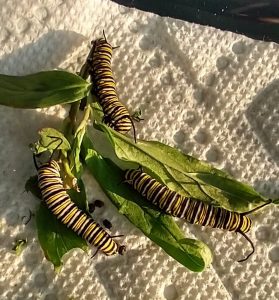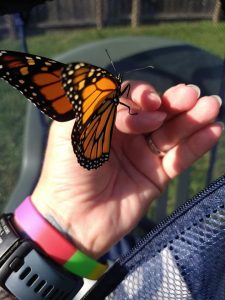As summer turns to fall, monarch butterflies begin their annual migration south to their wintering ground in Mexico. In this guest blog post, PRN member Martha McSims recounts her experience raising and releasing these beautiful butterflies.
When did you start raising monarchs and how did you get started?
 I started raising monarchs in 2020, so this is my second season. It was a nice project to keep my mind off what was going on during the pandemic. My wife Tammy researched different types of milkweed, and in the Spring of 2020, we planted two swamp milkweed plants in our yard. I honestly didn’t think I would get any monarchs laying eggs the first season, but I did. This year we planted 6 more swamp milkweed plants and butterfly weed. Literally, the first thing to get started is to plant milkweed.
I started raising monarchs in 2020, so this is my second season. It was a nice project to keep my mind off what was going on during the pandemic. My wife Tammy researched different types of milkweed, and in the Spring of 2020, we planted two swamp milkweed plants in our yard. I honestly didn’t think I would get any monarchs laying eggs the first season, but I did. This year we planted 6 more swamp milkweed plants and butterfly weed. Literally, the first thing to get started is to plant milkweed.
How many have you raised and released thus far?
As of September 15, I have released a total of 88 monarchs, 61 of them this year with the possibility of 4 more.
What motivated you to start raising them?
In 2019, I cat-sat for my friend Jackie who also raises monarch and swallowtail butterflies. She asked me to release any butterflies that emerged the week I was cat sitting. At first, I was nervous. I am very knowledgeable about cats, but butterflies, I was terrified I was going to release them wrong. It’s funny to think about it now. She left me detailed instructions on how to release them. After I released that first one, and observing this absolutely beautiful creature fly up to a tree, I was hooked. At that moment, I knew this was something I wanted to get involved in. I talked to my friend Jackie on how to get started, and I pretty much bugged her daily with questions the entire summer of 2020 and now I am having the time of my life raising, releasing, and learning as much as I can about our state insect.
What does a typical day look like in caring for them?
How do you do it? What resources do you need? How much time do you dedicate to it? Is this something anyone can do?
 A typical day for me is:
A typical day for me is:
- Checking the milkweed daily for eggs. The monarch lays one egg per leaf and it is on the bottom and typically at the rear of the leaf. Once I find eggs, I bring them in, rinse the leaf well, cut the leaf in half, put the cut leaf on a fresh leaf, put on a piece of paper towel, and put in a condiment cup with lid.
I do the following twice a day.
- Rinse and dry milkweed leaves for the caterpillars. It’s super important to make sure the leaves are dry as the moisture can cause mildew in the containers. Clean the frass (caterpillar poop) out of containers. Cleaning the frass is super important as well as it can cause disease to the caterpillar if they sit in their frass too long. I bought a keyboard duster this year and it is awesome at sucking up the frass without bothering the caterpillar.
When the caterpillars are ready, I transfer them to a new and bigger container. I have three different size containers. They spend (until 3rd instar) in a condiment cup. Then they move to what I call an apartment which is a plastic shoe container. After they move to an apartment, they get a name. This year, I went down the alphabet to name them. I used friends, family, and google when naming them. My family and friends were excited about this and would check in to see how their caterpillar was doing. When they reach the 4th instar stage, I put them in a mesh container and that’s where they will head to the top to form their chrysalis.
 When the butterfly emerges and their wings dry, I release them.
When the butterfly emerges and their wings dry, I release them.
At the end of the day, I type in my data for the day. I have a color coded data sheet with: date I found egg, date egg hatched, date of when caterpillar went in a “J,” date when it emerged, date when I released it, and if it was “M” or “F.” I didn’t do this last year, but it’s been neat to go back through this season and look at the data. I will continue to do this.
I typically spend about two hours a day with these guys. There are ways to cut the time down, but I have been told I am an over-protective cat mom. I enjoy spending the extra time cleaning their leaves and studying their behavior. There is a joke in my house, my family will not see me in July and August.
Anyone can do this. All you need to do is plant milkweed and they will come. I also recommend doing quite a bit of research on raising them. It’s an extraordinary hobby, but there is a lot of information out there to raise them successfully. The beauty of it is I am still learning and I hope to study more about the monarch butterfly during this next off season.
The monarch population has been declining for years. The reason being, milkweed habitat destruction, use of pesticides, and climate change. In the words of Max Lucado, “No one can do everything, but we can all do something.” This is the one thing I can do to help the monarch population. I can’t imagine a world of walking through a wildflower patch and not seeing a monarch. Can you? Every time I release a beautiful butterfly, my heart skips a beat and I smile because I was a part of that.
Lifecycle of a Butterfly
 The whole process takes about 30 days. During cooler temps, the process takes longer.
The whole process takes about 30 days. During cooler temps, the process takes longer.
- Egg- the egg hatches between 3-5 days. After the egg hatches, the eggshell is the first meal for the caterpillar, then it starts to look for milkweed.
- Larva(caterpillar)-10-14 days. When the caterpillar becomes to large for its skin, it goes through a molting process. The intervals between molts are called instars. The caterpillar will go through 5 instars during the 10-14 days.
- Pupa(chrysalis)-10-14 days
- Adult-when the butterfly emerges, it’s wings are scrunched up. Once the wings dry, it’s the most beautiful creature. Butterflies can be released after 2-4 hours. I tend to wait at least 8 hours, so I know their wings are completely dry and strong.
Fun Caterpillar/Butterfly Facts
- There is no way to tell the sex of a caterpillar. You have to wait until it emerges as a butterfly.
- Males have a black spot on a vein on each hind wing that is not present on the female.
- Butterflies taste with their feet and smell with their antennae
Prairie Rivers Network works with partners such as the National Wildlife Federation, farmers, and private landowners to ensure that we create more spaces for pollinators and insects to live. Any landowner can help pollinators by adding the native flowering plants they depend on to their properties. Let diversity thrive in your yard, “Embrace the dandelion!” and don’t use lawn chemicals or insecticides.







